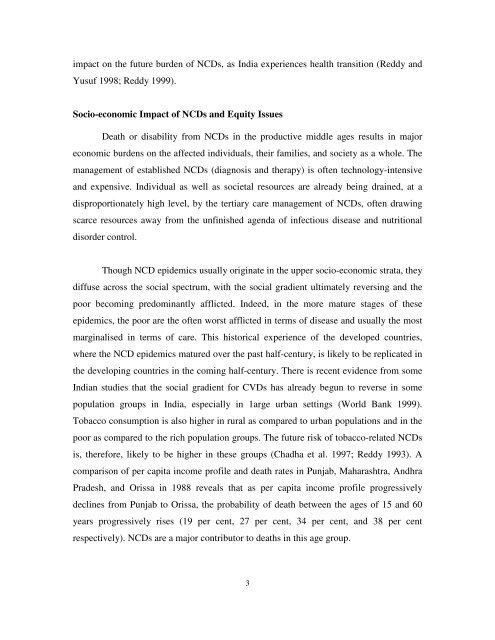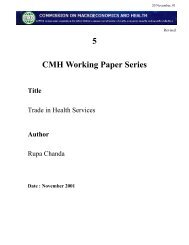prevention and control of non-communicable diseases - icrier
prevention and control of non-communicable diseases - icrier
prevention and control of non-communicable diseases - icrier
Create successful ePaper yourself
Turn your PDF publications into a flip-book with our unique Google optimized e-Paper software.
impact on the future burden <strong>of</strong> NCDs, as India experiences health transition (Reddy <strong>and</strong><br />
Yusuf 1998; Reddy 1999).<br />
Socio-economic Impact <strong>of</strong> NCDs <strong>and</strong> Equity Issues<br />
Death or disability from NCDs in the productive middle ages results in major<br />
economic burdens on the affected individuals, their families, <strong>and</strong> society as a whole. The<br />
management <strong>of</strong> established NCDs (diagnosis <strong>and</strong> therapy) is <strong>of</strong>ten technology-intensive<br />
<strong>and</strong> expensive. Individual as well as societal resources are already being drained, at a<br />
disproportionately high level, by the tertiary care management <strong>of</strong> NCDs, <strong>of</strong>ten drawing<br />
scarce resources away from the unfinished agenda <strong>of</strong> infectious disease <strong>and</strong> nutritional<br />
disorder <strong>control</strong>.<br />
Though NCD epidemics usually originate in the upper socio-economic strata, they<br />
diffuse across the social spectrum, with the social gradient ultimately reversing <strong>and</strong> the<br />
poor becoming predominantly afflicted. Indeed, in the more mature stages <strong>of</strong> these<br />
epidemics, the poor are the <strong>of</strong>ten worst afflicted in terms <strong>of</strong> disease <strong>and</strong> usually the most<br />
marginalised in terms <strong>of</strong> care. This historical experience <strong>of</strong> the developed countries,<br />
where the NCD epidemics matured over the past half-century, is likely to be replicated in<br />
the developing countries in the coming half-century. There is recent evidence from some<br />
Indian studies that the social gradient for CVDs has already begun to reverse in some<br />
population groups in India, especially in 1arge urban settings (World Bank 1999).<br />
Tobacco consumption is also higher in rural as compared to urban populations <strong>and</strong> in the<br />
poor as compared to the rich population groups. The future risk <strong>of</strong> tobacco-related NCDs<br />
is, therefore, likely to be higher in these groups (Chadha et al. 1997; Reddy 1993). A<br />
comparison <strong>of</strong> per capita income pr<strong>of</strong>ile <strong>and</strong> death rates in Punjab, Maharashtra, Andhra<br />
Pradesh, <strong>and</strong> Orissa in 1988 reveals that as per capita income pr<strong>of</strong>ile progressively<br />
declines from Punjab to Orissa, the probability <strong>of</strong> death between the ages <strong>of</strong> 15 <strong>and</strong> 60<br />
years progressively rises (19 per cent, 27 per cent, 34 per cent, <strong>and</strong> 38 per cent<br />
respectively). NCDs are a major contributor to deaths in this age group.<br />
3

















